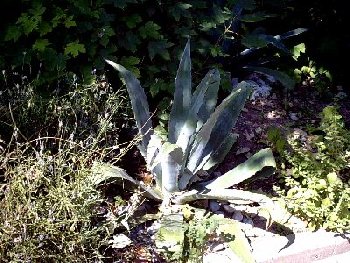
Site Surveys August 2003 And January 2004
Our site surveys on Heligoland on August 25th and 26th in 2003 and from January 14th till 18th in 2004 brought us surprising results. We could check the list of the "exotics" growing in Heligoland which I had discovered on the internet. Our expectations also were exceeded. The incomplete plant list for Heligoland from the Nature Historical Association of Nuremberg (Naturhistorische Gesellschaft Nürnberg) contained:
|
Araucaria araucana |
|
Castanea sativa |
|
Fatsia japonica |
|
Ficus carica |
|
Fuchsia magellanica |
|
Laurus nobilis |
|
Morus nigra |
|
Quercus ilex |
This is out-dated, must be completed by:
|
Aucuba japonica |
|
Camelia japonica |
| Chamaerops humilis |
| Cinnamomum camphora |
|
Cordyline australis |
|
Erica arborea |
|
Euonymus japonica |
| Fargesia murilae |
| Furcraea longaeva 'Variegata' |
|
Hebe x franciscana |
|
Hibiscus syriacus |
|
Lavendula angustifolia |
| Nerium oleander |
| Pelargonium sp. |
|
Phillyrea latifolia |
|
Phyllostachys aurea |
|
Rosmarinus officinalis |
|
Santolina chamaecyparissus |
|
Trachycarpus fortunei |
| Viburnum tinus |
|
Yucca flaccida |
|
Yucca gloriosa |
Surprisely Fatsia japonica, Araucaria araucana, Fuchsia magellanica and Euonymus japonica are quite common on Heligoland. I have seen several beautiful great Fatsia japonica and also some big beautiful specimens of Araucaria araucana on the Upper Land and on the Lower Land. The fuchsias in the garden of the Mielck House are kept under 7 feet by a gardening company. However I saw one 7 feet tall Fuchsia magellanica in one private garden on the Upper Land.
Also we could find for our surprise besides Quercus ilex, Ficus carica, Laurus nobilis and Fuchsia magellanica another 6 Trachycarpus fortunei (the largest one is 7 feet tall) and I found under the trachys some Camelia japonica. In the same garden we saw two approx. 16 feet tall Quercus ilex, their trunks meassure about 8 inches in the diameter. The Laurus nobilis is one more than 10 feet tall tree with a trunk diameter of 8 inches, had never frost damages and is unlike my in Hamburg outplanted laurel never killed back, my laurel is killed back two times. The three trees are more than 20 years old and were planted in the eighties of the last century by the former administrator out. The fig is also never frozen back and the fruits are also ripening on Heligoland. All "exotics" have never got winter protection! The Quercus ilex have set germinateable acorns and the Trachycarpus fortunei have already flourished.
Scattered on the Lower Land and also on the Upper Land we found another 8 trachys in public enclosures and also in some private gardens. Unfortunately, the 3 trachys show defect appearances in a little park on the Lower Town on the Lower Land, they are only approx. 2 feet tall. Hardly anyone waters and fertilizes them. On the other hand, the trachys look much better in the garden of the Mielck House and in private gardens. The trachys don't know any winter protection on Heligoland, never had heart rottenness and the Chinosol treatment against heart rottenness is also unknown. Heligoland is a place of Germany where palms thrive without winter protection outdoors!
At the post office in the Lower Town on the Lower Land we saw a tall Camelia japonica, this one according to Mr. Neulen, the retired island gardener of Heligoland, flourishes already in January with white flowers. You see camelias scattered on Heligoland in private gardens and also on some public places, in the garden of Mr. Neulen self. Also winter protection measures and frost damages are unknown to them, unlike the specimens of the same species on the mainland.
Unfortunately, we could find only one single trunk forming yucca outplanted on Heligoland, it's Yucca gloriosa, it is in the park of the health cure house. But we found Yucca flaccida, one also on the mainland completely hardy trunkless yucca in the private gardens. However, Yucca gloriosa looks on Heligoland good and is grown well, but it was cutten back.
On the Upper Land we saw a more than 180 years old Morus nigra in the parish priest garden, this mulberry tree has survived 2 World Wars and the Big Bang of 1947.
We have discovered only one single "exotic" in the allotments on the Upper Land, one small fig tree (Ficus carica). From time to time we could discover Hibiscus syriacus in different varieties (pink and white with a red eye) in the private gardens.
We also still could discover a Phillyrea latifolia (stone limewood) at the swimming pool and nearby the crazy golf place on the northeast area, the plant is completely healthy and has grown very well, is 7 feet tall. I also have one of the same species in my garden in Hamburg, a friend brought it to me from Majorca, also hardy in Hamburg.
As we wanted to go out to eat still in the evening, I discovered one Hebe x franciscana in a trough at the entrance of the North Sea hall, which had dead older foliage, the young this year's foliage healthy and I checked the plant and found that it's a older and must have probably survived without winter protection outdoors. On the mainland, also in Hamburg, it don't survive any normal winter outdoors, only such winters like 1988/89 and 1999/2000 (at this time lowest temperatures in Hamburg 21°F and 18°F). Further specimens I still found at the next day in the Lower Town in troughs in better condition, they also seem to be older, not fresh from flower shops or nurseries.
We also have discovered two outplanted Cordyline australis at the Bistro Sanisbar in the Lower Town. But the bistro owner told me that the both are from the nursery in Bremen/Germany and only recently outplanted, they didn't have outdoor winter experience yet. However, the bistro owner want to overwinter them outdoors. We saw further cordylines in pots in the nearbier surroundings. On the second site survey in January 2004 we noticed that all of the cordylines already have survived 28°F without problems, are stayed without damages. We will watch further!
Also Aucuba japonica can be seen in private gardens from time to time, there completely hardy. Also Mr. Neulen has one in his garden. In Hamburg self I also have one plant which also survives in Hamburg at sheltered places the winters outdoors.
Bamboo also does grow on Heligoland, but only at good wind sheltered places in some few private gardens. In the Upper Town on the Upper Land I saw one Pseudosasa japonica, one relative small plant which but is in the good condition. In the addition I still discovered Santolina chamaecyparissus and Rosmarinus officinalis outplanted in one private garden, also Lavendula angustifolia is to find in the private gardens.
We went to conversations and further excursions to Heligoland once more in January 2004. On the arrival we have come past away at the hotel "Insulaner" and have made an excursion there, we also could see the hotel garden. We saw a healthy firm big double sturdy Phoenix canariensis in the pot on the terrace under the balcony lead in a corner. Rickmers told us that the Phoenix has already overwintered outdoors n the pot completely unprotected for over 3 years. He wants to unpot the palm and plant it out. A second of the same species also is in the pot stands completely unprotected in the garden, one sees the last summer 2003 on it, it recovers just from the drought damages, has formed only small leaves.To this I also saw a recently planted Phyllostachys aurea in the same garden. Then we also saw the windmill palms again, the big one had clapped-out Christmas trees around itself in the little park in the lower town. Welfare as wind protection. I also saw geraniums and bush daisies which showed themselves almost unimpressed of 28°F. I also saw rhododendrons, there I also thought about Rhododendron arboreum, falconeri, macabeanum and other rhododendron species which are not hardy on the mainland, they also have chances on Heligoland. There are even more fig-trees on Heligoland, not only at the Mielck House and in one allotment on the Upper Land, Rickmers also has one and even in the spa garden on the northeast area there is a strongly cutten back fig-tree.
We saw a small Erica arborea in a garden on the Upper Land which has proved to be hardy on Heligoland. Also several ferns which aren't sufficiently hardy on the mainland. We experienced another great surprise as we made a small excursion with Neulen and his son on the Lower Land and on the northeast area. We discovered a camphor tree (Cinnamomum camphora) behind the windmill palm group on the wall of the Mielck House, the former administrator of the Mielck House also had planted it out. The camphor tree has suprisely proved to be easy on Heligoland, never winter protection, but at a place well sheltered from the wind. Camphor trees are a little more sensitive than Laurus nobilis, aren't hardy in any area on the mainland. It is already hardy in the U. K. in milder areas. I could identify it. Nearby the camphor tree and the windmill palm group I saw an Olea europaea in the pot at the wall without every damage. Olives also could be hardy an Heligoland, trial plantations will follow. We also wanted to check the agaves on the northeast area whether they have come through well, but one has taken them out again and brought them to overwinter frostfree. 28°F aren't much for the agaves, however there are several hardier agave species which we will test! Some which are hardy enough for Heligoland could be found. In the near we also saw a Phyllostachys planted recently, it was in a very bad condition, the summer was too dry and one hadn't sufficiently take care it.
Before we looked around on the northeast area, I have discovered one Fargesia murilae in the near of the double-trunked Trachycarpus fortunei in the Lower Town, the classic garden bamboo, it was recently planted. I saw at it that it suffered under the dry summer in 2003 and also said to Neulen, that the summer was too dry. He agreed this. This is no wonder either since my fargesias in my garden in Hamburg which I had grown from seed some years ago also also had suffered and but have recovered again.
On the Upper Land I still discovered another outdoor location of Rosmarinus officinalis not far from the Hagmeier House in a private garden. Also near the bistro Sansibar I also discovered Viburnmum tinus besides the cordylines in the pot without every damage. At a bar in the Lower Town we discovered a Furcraea longaeva 'Variegata' in a trough, seems to be easy on Heligoland, to try on Heligoland, not hardy on the mainland.
We have learned in March 2004 by a telephone call with one Heligolandian that Nerium oleander are outplanted at a sheltered place without winter protection on his business area on the South Beach already for several years. Briefly, I had received an e-mail before that two mimosas (Acacia sp.) are standing in a garden in pots on the Upper Land since 3 years. I have requested the owner to take photos of his mimosas for the purpose of a more exact species regulation. Also I suggested him to plant them out. Heligoland is always good for botanic surprises!
Also at the bistro Sansibar stands a Viburnum tinus which had come at first in the pot through the winter outdoors and was then planted in the following spring out. And Chris Stuehrk still discovered some Chamaerops humilis in pots on the South Beach which apparently also have overwintered outdoors and still are in good condition. A Furcraea longaeva 'Variegata' also came through the winter in a trough without damages at a restaurant in the Lower Town.
If you see this all so, Heligoland has an "exotic kinder" climate than the mainland. Some "exotics" like Fatsia japonica, Araucaria araucana, Fuchsia magellanica and Euonymus japonica are frequent on Heligoland to our delight. The not small number of Trachycarpus fortunei surprised and pleased us, I counted about 15 Trachycarpus fortunei is completely hardy on Heligoland, survives there without any winter protection every winter!
Hardly a plant species is really indigenous to Germany, before the ice ages had Germany a subtropical plant world with a very large number of species, many actually gardeningly valuable species are extincted by the ice ages. And others have survived in the other parts of the world, and have returned only by the postglacial warming and humans. Even palms were in tertiarily indigenous much further to the north to Southern Greenland, Spitzbergen and Scandinavia in Europe, fossilies also prove this. Even in the mildest areas of Norway (e. g. Sør-Hidle near Stavanger) one has planted successfully Trachycarpus fortunei and Araucaria araucana out.
Hardly a plant species is also indigenous to Heligoland, many have come onto the island by humans, partly deliberate by the introduction of garden and park plants and partly unintentionally by pollutions of shipping cargo loads etc. Also birds play an important role in the distribution of "exotics".

Agave americana on Heligoland in pots in the
ground, without outplantation trial.
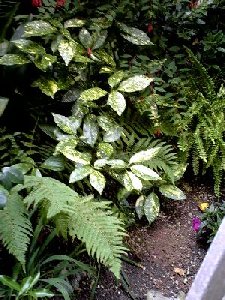
Aucuba japonica
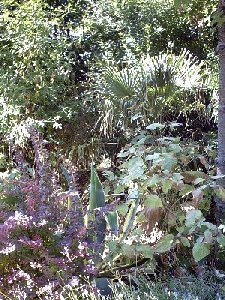
Outplanted Trachycarpus fortunei in
the background and dug in Agave
americana 'Variegata' in pot
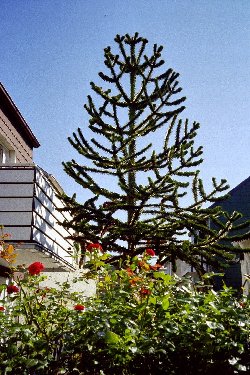
Araucaria araucana
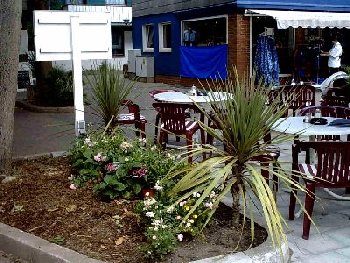
Cordyline australis
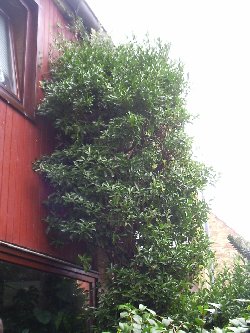
Euonymus japonica
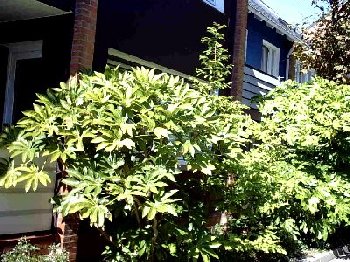
Fatsia japonica
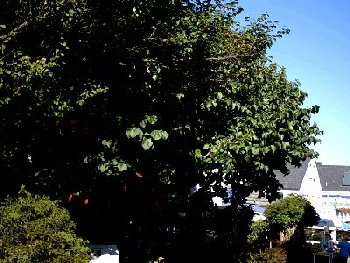
Morus nigra
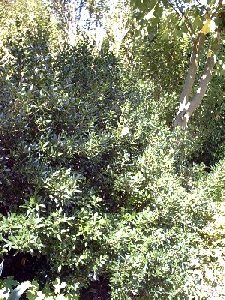
Phillyrea latifolia
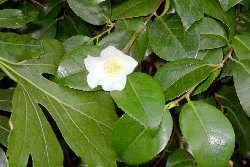
Camelia japonica
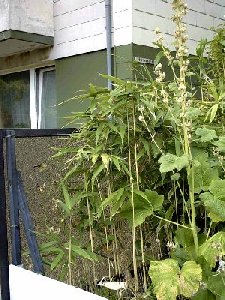
Pseudosasa japonica
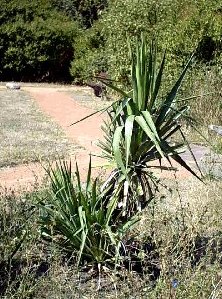
Yucca gloriosa
The photos above are only one small part of them from the which were taken on our trip in August 2003. There are much more photos to see, also the from January 2004, please click the links below on! Unfortunately only in German language titled.
To The Photo Gallery Excursion August 2003 (unfortunately only in German)
To The Photo Gallery Excursion January 2004 (unfortunately only in German)
Author: Joachim Jaeck
Updated June, 24th, 2004